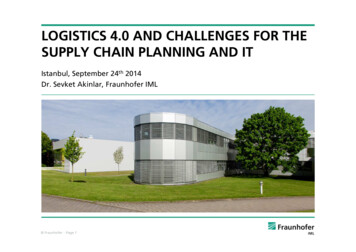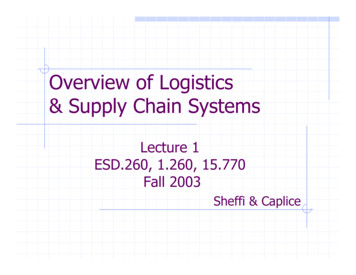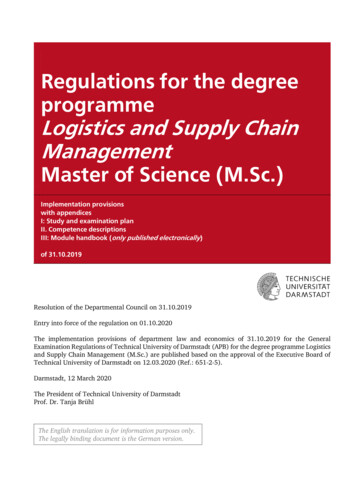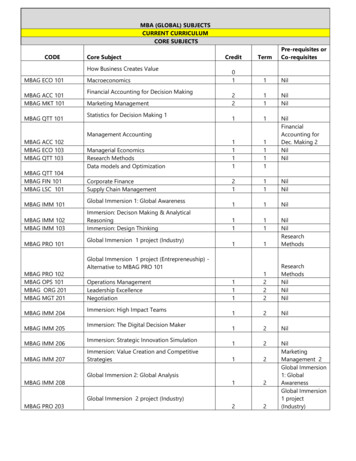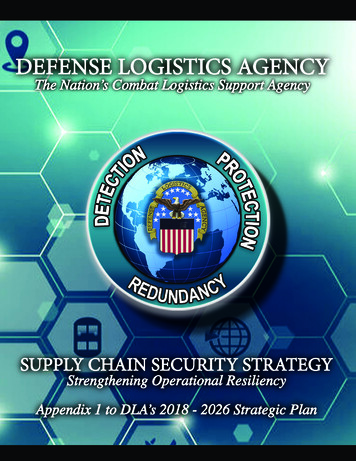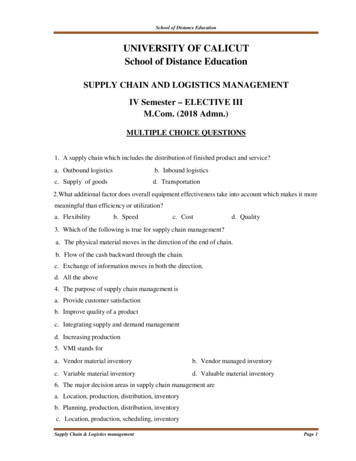
Transcription
S UPPLY CHAIN and LOGIS TICSTERMS and GLOSS ARYUpdated February, 2010AA3 Method: The A3 system is a means of describing a business process in a compact form. It was originally created by the Toyota MotorCorporation and was named for the paper size on which it was printed: A3 (11” x 17”). Toyota used the A3 methodology to help develop its famedToyota P roduction System (TP S).Abandonment: (1) The decision of a carrier to give up or to discontinue service over a route. Railroads must seek ICC permission to abandon routes.(2) As in the phrase "call abandonment". This refers to people who, being placed on hold in an incoming call, elect to hang up ("abandon") the call.Call centers monitor closely the "abandonment rate" as a measure of their inefficiency.ABB : See: Activity Based BudgetingABC: See: Activity Based CostingABC Classif ication: A method of classifying inventory items relative to their impact on total control. ABC typically uses movement and cost data tocalculate the value of stock usage over the prior period, and uses the result as an element in ranking items under an 80/20 P areto rule for cyclecounting purposes. The group is divided into classes called A, B, and C (and sometimes D) with The A group represents the highest value with 10 to20% by number of items. The B, C and D (if used) groups are each lower values but typically higher populations. Items with higher usage value are(the 20%) are counted more frequently. Specific bars to be used in setting ABC levels will vary by organization as they will impact the financialcontrol applied to inventory and the level of effort spent counting. See: Cycle CountingABC Costing: See: Activity Based CostingABC Frequency of Access: Location method where the determination of a product’s location within the warehouse, or distribution center, is basedon 1) product’ s ABC Classification and 2) the number of times or rate of which the product is accessed.ABC Inventory Control: A method of inventory control which divides items into categories based on value of usage, something like a P aretodivision where the items which constitute the highest dollar value are tracked more closely than those with lower value movement. In this method anitem with high volumes of movement, but low cost, such as a small cheap fastener, would likely be counted less frequently than a slower moverwhich has a very high cost. Items are typically divided by a company defined set of values into “ A”,“ B” and “ C” groups, and sometimes even a “ D”group. The count frequencies are then applied to the groups. For example “ A” class items may be counted weekly,“ B” monthly,“ C” quarterly, etc.as a part of a cycle counting program.ABC Model: In cost management, a representation of resource costs during a time period that are consumed through activities and traced toproducts, services, and customers or to any other object that creates a demand for the activity to be performed.ABC System: In cost management, a system that maintains financial and operating data on an organization’s resources, activities, drivers, objectsand measures. ABC models are created and maintained within this system.AB M: See: Activity Based ManagementAbnormal Demand: Demand for a product which is either greater or lower than expected by a given percentage which is determined by theorganization. When observed, it should be determined whether it may be a one-time spike, or if the effect is part of a trend which should beconsidered during future forecasts.ABI: See: Automated Broker InterfaceAB P: See: Activity Based PlanningAbsorption Costing: A cost accounting approach which captures overhead and other indirect costs as separate from unit costs for a given period,and then applies (absorbs) those costs into unit costs at the period end based on various factors such as movement and COGS elements.Please note: The International Warehouse Logistics Association (IWLA) does not take responsibility for the content of these definitions and does not endorse these as officialdefinitions.Definitions compiled by:Supply Chain Visionswww.scvisions.comBellevue, WashingtonPage 1 of 136
S UPPLY CHAIN and LOGIS TICSTERMS and GLOSS ARYUpdated February, 2010ACAT: See: Acquisition CategoriesAcceptable Q uality Level (AQ L): In quality assessment, acceptable quality level, also known as assured quality level, describes the maximumnumber of defects acceptable during the random sampling of an inspection.Acceptable Sampling Plan: A quality management procedure which defines the sample sizes and acceptable defect levels for validating quality ofproducts.Acceptance Number: See: Acceptable Quality LevelAcceptance Sampling: A statistical quality control method which tests samples of products at defined points as opposed to testing each product.Accessibility: The ability of a carrier to provide service between an origin and a destination.Accessory: A feature which can optionally be added to a finished good at the discretion of the customer. An example would be the addition of aspecial trim feature to an automobile.Accessorial Charges: A carrier’ s charge for accessorial services such as loading, unloading, pickup, and delivery. Also see: Upcharges.Accessorial Fee: See: Accessorial chargesAccountability: The act of making a group or individual responsible for certain activities or outcomes. For example, managers and executives areaccountable for business performance even though they may not actually perform the work.Accounts Payable (A/P): 1) a financial term referring to the amount of transactions which have been accrued but not paid to a vendor. 2) Anaccounting functionAccounts receivable (A/R): On a company's balance sheet, accounts receivable is the amount that customers owe to that company. Sometimes calledtrade receivables, they are classified as current assets assuming that they are due within one year.Accreditation: The process in which certification of competency, authority, or credibility is presented. An example of accreditation is theaccreditation of testing laboratories and certification specialists that are permitted to issue official certificates of compliance with establishedstandards.Accredited Standards Committee (ASC): A committee of the ANSI chartered in 1979 to develop uniform standards for the electronic interchangeof business documents. The committee develops and maintains U.S. generic standards (X12) for Electronic Data Interchange.Accumulation bin: An area where item to be used in assembly of a product are staged prior to work being done. See: StagingAccuracy: A value, usually expressed as a percentage, which expresses the level of precision incurred during transactions. An example would beseen when comparing actual inventory levels to what was expected from bookkeeping records.ACD: See: Automated Call DistributionACE: See: Automated Commercial EnvironmentACH: See: Automated ClearinghouseAcknowledgment: Typically this is a response, either electronic or as a physical document, which confirms the receipt of an order from the supplierto the buyer.Acquisition Categories (ACAT): U.S. DoD ACAT 1 programs are Milestone Decision Authority P rograms or programs designated ACAT 1 by theMilestone Decision Authority.Please note: The International Warehouse Logistics Association (IWLA) does not take responsibility for the content of these definitions and does not endorse these as officialdefinitions.Definitions compiled by:Supply Chain Visionswww.scvisions.comBellevue, WashingtonPage 2 of 136
S UPPLY CHAIN and LOGIS TICSTERMS and GLOSS ARYUpdated February, 2010Acquisition Cost: The net price plus other costs needed to purchase the item and get it to the point of use. These other costs can include: the item'spurchasing costs (closing, research, accounting, commissions, legal fees), transportation, preparation and installation costsACSI: See: American Customer Satisfaction IndexAction Message: A system message usually created during MRP calculations to call attention to a current or potential problem and suggestcorrective action.Action Plan: A specific method or process to achieve the results called for by one or more objectives. An action plan may be a simpler version of aproject plan.Action Report: See: Action MessageActivation: TOC recognizes that it is possible to produce without contributing to throughput. TOC defines production that contributes to throughputas utilization.P roduction that does not contribute to throughput is known as activation. Activation is not desired because it not only fails to increasethroughput, but it also increases inventory and operating expense. This is consistent with the Just-In-Time (JI T) philosophy.Active Inventory: Materials held in a facility, which are intended to be consumed in manufacturing / assembly, or sold in a specified periodActive Stock: Goods in active pick locations and ready for order filling.Activity: Work performed by people, equipment, technologies or facilities. Activities are usually described by the “ action-verb-adjective-noun”grammar convention. Activities may occur in a linked sequence and activity-to-activity assignments may exist.Activity Analysis: The process of identifying and cataloging activities for detailed understanding and documentation of their characteristics. Anactivity analysis is accomplished by means of interviews, group sessions, questionnaires, observations, and reviews of physical records of work.Activity Based B udgeting (ABB ): An approach to budgeting where a company uses an understanding of its activities and driver relationships toquantitatively estimate workload and resource requirements as part of an ongoing business plan. Budgets show the types, number of and cost ofresources that activities are expected to consume based on forecasted workloads. The budget is part of an organization’s activity-based planningprocess and can be used in evaluating its success in setting and pursuing strategic goals.Activity B ased Costing (ABC): A methodology that measures the cost and performance of cost objects, activities and resources. Cost objectsconsume activities and activities consume resources. Resource costs are assigned to activities based on their use of those resources, and activity costsare reassigned to cost objects (outputs) based on the cost objects proportional use of those activities. Activity-based costing incorporates causalrelationships between cost objects and activities and between activities and resources.Activity-B ased Management (AB M): A discipline focusing on the management of activities within business processes as the route to continuouslyimprove both the value received by customers and the profit earned in providing that value. ABM uses activity-based cost information andperformance measurements to influence management action.See: Activity-Based CostingActivity B ased Planning (AB P): Activity-based planning (ABP ) is an ongoing process to determine activity and resource requirements (bothfinancial and operational) based on the ongoing demand of products or services by specific customer needs. Resource requirements are compared toresources available and capacity issues are identified and managed. Activity-based budgeting (ABB) is based on the outputs of activity-basedplanning.Activity Dictionary: A listing and description of activities that provides a common/standard definition of activities across the organization. Anactivity dictionary can include information about an activity and/or its relationships, such as activity description, business process, function source,whether value-added, inputs, outputs, supplier, customer, output measures, cost drivers, attributes, tasks, and other information as desired to describethe activity.Activity Driver: The best single quantitative measure of the frequency and intensity of the demands placed on an activity by cost objects or otheractivities. It is used to assign activity costs to cost objects or to other activities.Activity Level: A description of types of activities dependent on the functional area. P roduct-related activity levels may include unit, batch, andproduct levels. Customer-related activity levels may include customer, market, channel, and project levels.Please note: The International Warehouse Logistics Association (IWLA) does not take responsibility for the content of these definitions and does not endorse these as officialdefinitions.Definitions compiled by:Supply Chain Visionswww.scvisions.comBellevue, WashingtonPage 3 of 136
S UPPLY CHAIN and LOGIS TICSTERMS and GLOSS ARYUpdated February, 2010Activity Network Diagram: An arrow diagram used in planning and managing processes and projects.Actual Cost System: A managerial accounting system that records and measures all cost elements at their actual acquisition value. Indirect costs arethen applied as overhead using a cost allocation techniqueActual Costs: The actual labor, material, and allocated overhead costs incurred in the acquisition or production of a product.Actual Demand: The known demand for a specific product based on customer orders and production orders which are open. Once an order isshipped or production is completed, specific demand quantity will become usage. Actual demand should be netted against any forecast for the sameperiod, meaning that as orders are received the are considered to be part of an earlier forecast and forecasts should be considered as satisfied.Actual to Target Gap Analysis: See: Gap AnalysisActual to Theoretical Cycle Time: The ratio of the measured time required to produce a given output divided by the sum of the time required toproduce a given output based on the rated efficiency of the machinery and labor operations.Adaptive Smoothing: A special type of exponential smoothing that takes the success of previous forecasts into account when setting a value ofALP HA for the next period. In this manner, periods that experienced high error wll cause ALP HA to be set high and, thus, adjust quickly. Whenerror is low, AS assumes the technique is doing well and sets ALP HA at a low level. This makes ES much more responsive to changes in the level ofthe data and less reactive to noise. The advantage to adaptive smoothing is that the decision of what value of ALPHA to use in exponential smoothingis eliminated. A disadvantage to adaptive smoothing is that trend and seasonality are ignoredADR: See: Alternate Dispatch ResolutionAdvance Material Request: A request for materials which is created in advance of for mal need due to long lead times for components, etc.Advanced Planning and Scheduling (APS): Refers to a manufacturing management process by which raw materials and production capacity areoptimally allocated to meet demand. AP S is especially well-suited to environments where simpler planning methods cannot adequately addresscomplex trade-offs between competing priorities.Advanced Shipping Notice (ASN): Detailed shipment information transmitted to a customer or consignee in advance of delivery, designating thecontents (individual products and quantities of each) and nature of the shipment. In EDI data standards it is referred to as an “ 856 transaction.” It mayalso include carrier and shipment specifics, including time of shipment and expected time of arrival. Also known as an assumed receipt.Af termarket: A market for parts and accessories used in the repair or enhancement of a product. A secondary market created after the originalmarket sales are finished.Af ter-Sale Service: Services provided to the customer after products have been delivered. This can include repairs, maintenance and/or telephonesupport. Synonym: Field Service.Agency Tariff : A publication of a rate bureau that contains rates for many carriers.Agent: An enterprise authorized to transact business for, or in the name of, another enterprise.Agile Manufacturing—Tools, techniques, and initiatives that enable a plant or company to thrive under conditions of unpredictable change. Agilemanufacturing not only enables a plant to achieve rapid response to customer needs, but also includes the ability to quickly reconfigure operations—and strategic alliances—to respond rapidly to unforeseen shifts in the marketplace. In some instances, it also incorporates “ mass customization”concepts to satisfy unique customer requirements. In broad terms, it includes the ability to react quickly to technical or environmental surprises.Agglomeration: A net advantage gained by a common location with other companies.Aggregate Forecast: Forecasting of future demand for a family of products or for a single product across multiple dimensions of source - includingplanned production and customer orders.Please note: The International Warehouse Logistics Association (IWLA) does not take responsibility for the content of these definitions and does not endorse these as officialdefinitions.Definitions compiled by:Supply Chain Visionswww.scvisions.comBellevue, WashingtonPage 4 of 136
S UPPLY CHAIN and LOGIS TICSTERMS and GLOSS ARYUpdated February, 2010Aggregate Inventory: The total inventory available for any given product across multiple locations and/or multiple stock-keeping units.Aggregate Inventory Management: A method of managing inventory through the use of levels set against overall inventory or class value.Aggregate Plan: A plan for the production process, 2 to 18 months in advance to give management an idea to of what quantity of materials and otherresources are to be procured and when, so that the total cost of operations of the organization is kept to the minimum over that period.Aggregate Planning: An operational activity which compiles an aggregate plan for the production process.Aggregate Tender Rate: A reduced rate offered to a shipper who tenders two or more class-rated shipments at one time and one place.Agility: The ability to rapidly and cost effectively adapt to market changes with no significant negative impact on quality or dependability.AG VS: See: Automated Guided Vehicle System.Air Cargo: Freight that is moved by air transportation.Air Cargo Containers: Containers designed to conform to the inside of an aircraft. There are many shapes and sizes of containers. Air cargocontainers fall into three categories: 1) air cargo pallets 2) lower deck containers 3) box type containers.Airport and Airway Trust Fund: A federal fund that collects passenger ticket taxes and disburses those funds for airport facilities.Air Taxi: An exempt for-hire air carrier that will fly anywhere on demand: air taxis are restricted to a maxi mum payload and passenger capacity perplane.Air Transport Association of America: A U.S. airline industry association.Air Waybill (AWB): A bill of lading for air transport that serves as a receipt for the shipper, indicates that the carrier has accepted the goods listed,obligates the carrier to carry the consignment to the airport of destination according to specified conditions.Alaskan Carrier: A for-hire air carrier that operates within the state of Alaska.Alert: See: Action Message.Algorithm: A clearly specified mathematical process for computation; a set of rules, which, if followed, give a prescribed result.All-Cargo Carrier: An air carrier that transports cargo only.Allocated Item: A feature of an inventory control and order management system which allows for quantities available in inventory to be associatedwith a customer or production order so that the quantity cannot otherwise be usedAllocation: 1)In cost accounting, a distribution of costs using calculations that may be unrelated to physical observations or direct or repeatablecause-and-effect relationships. Because of the arbitrary nature of allocations, costs based on cost causal assignment are viewed as more relevant formanagement decision-making. 2) In order management, allocation of available inventory to customer and production orders.Allocation Costing: A method of allocating indirect / overhead costs to inventory items and costs of sales. See: Absorption CostingAlpha Release: A very early release of a product to get preliminary feedback about the feature set and usability.Alternate Routing: In a production environment this is an optional process for manufacturing or assembly of a product, which may be employed dueto unavailability of a primary work center, or choice of non-standard components. May also refer to a transportation route which is differ ent thanwhat would normally be taken, perhaps due to weather.Alternate Dispute Resolution (ADR): Any of a number of methods (such as mediation, arbitration, mock trials, etc) used to resolve disputesoutside of litigation.Please note: The International Warehouse Logistics Association (IWLA) does not take responsibility for the content of these definitions and does not endorse these as officialdefinitions.Definitions compiled by:Supply Chain Visionswww.scvisions.comBellevue, WashingtonPage 5 of 136
S UPPLY CHAIN and LOGIS TICSTERMS and GLOSS ARYUpdated February, 2010American Customer Satisfaction Index (ACSI): Released for the first time in October 1994, an economic indicator and cross industry measure ofthe satisfaction of U.S. household customers with the quality of the goods and services available to them—both those goods and services producedwithin the United States and those provided as imports from foreign firms that have substantial market shares or dollar sales. The ACSI is cosponsored by the University of Michigan Business School, ASQ and the CFI Group.American National Standards Institute (ANSI): A non-profit organization chartered to develop, maintain, and promulgate voluntary U.S. nationalstandards in a number of areas, especially with regards to setting EDI standards. ANSI is the U.S. representative to the International StandardsOrganization (ISO).American Society f or Q uality (ASQ ): A professional organization with more than 100,000 me mbers which advances learning, qualityimprovement, and knowledge exchange to improve business results, and to create better workplaces and communities worldwide.American Society f or Testing and Materials (ASTM): Not-for-profit organization that provides a forum for the development and publication ofvoluntary consensus standards for materials, products, systems and services.American Society for Training and Development (ASTD): A membership organization providing materials, education and support related toworkplace learning and performance.American Society of TransportationandLogistics: A professional organization in the field of logistics.American Standard Code for Inf ormation Interchange (ASCII): ASCII format - simple text based data with no formatting. The standard code forinformation exchange among data processing systems. Uses a coded character set consisting of 7-bit coded characters (8 bits including parity check).American Trucking Association, Inc.: A motor carrier industry association that is made up of subconferences representing various sectors of themotor carrier industry.American Waterway Operators: A domestic water carrier industry association representing barge operators on the inland waterways.AMC: The USAF Air Mobility Command's mission is to provide global air mobility. The command also plays a crucial role in providinghumanitarian support at home and around the world. AMC Airmen--active duty, Air National Guard, Air Force Reserve and Civil Reserve Air FleetAMFC: Air Force Materiel Command conducts research, development, testing and evaluation, and provides the acquisition management servicesand logistics support necessary to keep Air Force weapon systems ready for war. The command develops, acquires and sustains the aerospace powerneeded to defend the United States and its interests for today and tomorrow.Amtrak: The National Railroad P assenger Corporation, a federally created corporation that operates most of the United States’ intercity passengerrail service.Animated G IF: A file containing a series of GIF (Graphics Interchange Format) images that are displayed in rapid sequence by some Web browsers,giving an animated effect. Also See: GIF.AMS: See: Automated Manifest SystemAnalysis of Variance (ANOVA): A statistical term that refers to a collection of statistical models which test the means of several groups todetermine if the means are equal.Andon: A manufacturing term referring to a signboard incorporating signal lights, audio alarms, and text or other displays installed at a workstationto notify management and other workers of a quality or process problem.ANSI: See: American National Standards Institute.ANSI ASC X12: American National Standards Institute Accredited Standards Committee X12. The committee of ANSI that is charted with settingEDI standards.Please note: The International Warehouse Logistics Association (IWLA) does not take responsibility for the content of these definitions and does not endorse these as officialdefinitions.Definitions compiled by:Supply Chain Visionswww.scvisions.comBellevue, WashingtonPage 6 of 136
S UPPLY CHAIN and LOGIS TICSTERMS and GLOSS ARYUpdated February, 2010ANSI Standard: A published transaction set approved by ANSI. The standards are reviewed every six months.Anti-Def iciency Act [Title 31, U.S. Code, Sec1341and1517]: P rohibits making or authorizing an obligation in excess of the amount available;forbids obligation to pay money from the US Treasury in advance of the appropriation; requires agency to fix responsibility for violations of the Act.Anticipated Delay Report: A report, normally handwritten, which is created by the procurement and production areas to advise managementregarding orders which are not expected to be completed on time.Anticipation Inventories: Extra stocks of inventory which are being held above known requirement is order to accommodate trends or promotions.May also be used to hedge against risk of supply problems.Anticipation Order: An order placed in advance of the availability of a product for delivery at a future date. Anticipation orders are frequently usedin the retail environment where suppliers are previewing new products at trade shows and want to get a commitment fro m their retail customers priorto production of seasonal items.Any-Q uantity Rate (AQ ): The same rate applies to any size shipment tendered to a carrier; no discount rate is available for large shipments.Anti-Dumping Duty: An additional import duty imposed in instances where imported goods are priced at less than the normal price charged in theexporter's domestic market and cause material injury to domestic industry in the importing countryA/P: See: Accounts PayableApplicability Statement 2 (AS2): A specification for Electronic Data Interchange between businesses using the Internet's Web page protocol, theHypertext Transfer P rotocol (HTTP ). The specification is an extension of the earlier version, Applicability Statement 1 (AS1). Both specificationswere created by EDI over the Internet (EDIINT), a working group of the Internet Engineering Task Force (IETF) that develops secure and reliablebusiness communications standards.Application Service Provider (ASP): A company that offers access over the Internet to application (examples of applications include wordprocessors, database programs, Web browsers, development tools, communication programs) and related services that would otherwise have to belocated in their own computers. Sometimes referred to as “ apps-on-tap", ASP services are expected to become an important alternative, especially forsmaller companies with low budgets for information technology. The purpose is to try to reduce a company's burden by installing, managing, andmaintaining software.Application-to-Application: The direct interchange of data between computers, without re-keying.Approved Vendor List (AVL): List of the suppliers approved for doing business. The AVL is usually created by procurement or sourcing andengineering personnel using a variety of criteria such as technology, functional fit of the product, financial stability, and past performance of thesupplier.APS: See: Advanced Planning and SchedulingAQ: See: Any quantity rateAQ L: See: Acceptable Quality LevelA/R: See: Accounts ReceivableArmy Corps of Engineers: A federal agency responsible for the construction and maintenance or waterways.Arrival Notice: A notice from the delivering carrier to the Notify P arty indicating the shipment's arrival date at a specific location (normally thedestination).Arrow Diagram: A planning tool to diagram a sequence of events or activities (nodes) and the interconnectivity of such nodes. It is used forscheduling and especially for determining the critical path through nodes.Please note: The International Warehouse Logistics Association (IWLA) does not take responsibility for the content of these definitions and does not endorse these as officialdefinitions.Definitions compiled by:Supply Chain Visionswww.scvisions.comBellevue, WashingtonPage 7 of 136
S UPPLY CHAIN and LOGIS TICSTERMS and GLOSS ARYUpdated February, 2010Artificial Intelligence: Understanding and computerizing the human thought process.ASC: See: Accredited Standards Committee of ANSI.ASC X12: Accredited Standards Committee X12. A committee of ANSI chartered in 1979 to develop uniform standards for the electronicinterchange of business documents.ASCII: See: American Standard Code for Information InterchangeASN: See: Advanced Shipping Notice.ASP: See: Application Service ProviderASQ : See: American Society for QualityAS/RS: See: Automated Storage and Retrieval SystemAssociation of American Railroads: A railroad industry association that represents the larger U.S. railroads.ASTM: See: American Society for Testing and MaterialsASTD: See: American Society for Training and DevelopmentAS2: See: Applicability Statement 2Assemble-To-Order: A strategy employed in production and light manufacturing environments where complete subassemblies and components areassembled into a finished product just prior to customer shipment. Synonym: Finish to Ord
SUPPLY CHAIN and LOGISTICS TERMS and GLOSSARY Updated February, 2010 Please note:The International Warehouse Logistics Association (IWLA) does not take responsibilityfor the content of these definitions and doesnot endorse theseas official . Activity-Based Management (ABM): A discipline focusing on the management of activities within business .
